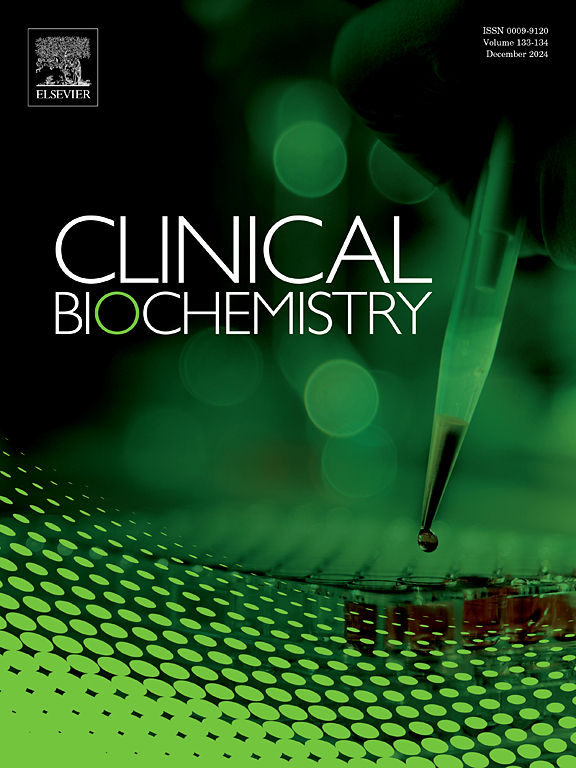一项前瞻性多中心队列研究表明,分泌神经素与血液透析患者的心血管事件或死亡率无关。
IF 2.5
3区 医学
Q2 MEDICAL LABORATORY TECHNOLOGY
引用次数: 0
摘要
摘要:分泌神经素(Secretoneurin, SN)是一种新型的心脏生物标志物,健康个体的参考上限为~ 60 pmol/L。高SN浓度与各种心脏疾病死亡风险增加有关。我们调查了接受维持性血液透析(HD)治疗的患者SN与心血管(CV)事件风险和全因死亡率之间的关系。材料和方法:前瞻性多中心队列研究,随访5年。基线时测定血清SN (pmol/L)。结果是CV事件(综合结果)和全因死亡率。根据SN浓度将种群分为三类:1类 143 pmol/L。采用Cox回归分析检验SN位数与结局的相关性。结果:该研究纳入了336例HD患者。SN浓度中位数为126 (100-153)pmol/L。在中位随访5.05(5.02-5.07)年期间,42%发生CV事件,60%死亡。尽管总体上SN浓度较高,但与样品1相比,样品2和样品3均与CV事件(hrterle2 1.27 (95% CI 0.84-1.93)和hrterle3 1.20 (95% CI 0.76-1.90)或全因死亡率(hrterle2 0.84 (95% CI 0.60-1.18)和hrterle3 0.90 (95% CI 0.62-1.31))的风险无关。结论:HD患者SN浓度较高;然而,5年随访后,SN与CV事件或全因死亡率无关。高浓度的SN可能与肾脏清除率受损和心肌病的高患病率有关,这可能限制了其与维持性HD患者预后的相关性。本文章由计算机程序翻译,如有差异,请以英文原文为准。
Secretoneurin is not associated with cardiovascular events or mortality in patients treated with hemodialysis: A prospective multicenter cohort study
Introduction
Secretoneurin (SN) is a novel cardiac biomarker with an upper reference limit of ∼60 pmol/L in healthy individuals. High SN concentrations have been associated with an increased risk of mortality in various cardiac diseases. We investigated the association between SN and the risk of cardiovascular (CV) events and all-cause mortality in patients treated with maintenance hemodialysis (HD).
Materials and Methods
Prospective multicenter cohort study with five years of follow-up. Serum SN (pmol/L) was measured at baseline. Outcomes were CV events (composite outcome) and all-cause mortality. The population was divided into tertiles according to SN concentrations: tertile 1 < 110.7 pmol/L, tertile 2 110.7–143 pmol/L, and tertile 3 > 143 pmol/L. The association between SN tertiles and outcomes was examined using Cox regression analysis.
Results
The study included 336 patients treated with HD. Median SN concentration was 126 (100–153) pmol/L. During a median follow-up of 5.05 (5.02–5.07) years, 42 % had a CV event and 60 % died. Despite overall high SN concentrations, neither SN tertile 2 nor SN tertile 3 was associated with the risk of CV events (HRtertile2 1.27 (95 % CI 0.84–1.93) and HRtertile3 1.20 (95 % CI 0.76–1.90)) or all-cause mortality (HRtertile2 0.84 (95 % CI 0.60–1.18) and HRtertile3 0.90 (95 % CI 0.62–1.31)), when compared to tertile 1.
Conclusions
Patients treated with HD have high SN concentrations; however, SN was not associated with CV events or all-cause mortality after five years of follow-up. High concentrations of SN, possibly explained by both impaired renal clearance and a high prevalence of cardiomyopathy, may limit its prognostic relevance in patients treated with maintenance HD.
求助全文
通过发布文献求助,成功后即可免费获取论文全文。
去求助
来源期刊

Clinical biochemistry
医学-医学实验技术
CiteScore
5.10
自引率
0.00%
发文量
151
审稿时长
25 days
期刊介绍:
Clinical Biochemistry publishes articles relating to clinical chemistry, molecular biology and genetics, therapeutic drug monitoring and toxicology, laboratory immunology and laboratory medicine in general, with the focus on analytical and clinical investigation of laboratory tests in humans used for diagnosis, prognosis, treatment and therapy, and monitoring of disease.
 求助内容:
求助内容: 应助结果提醒方式:
应助结果提醒方式:


